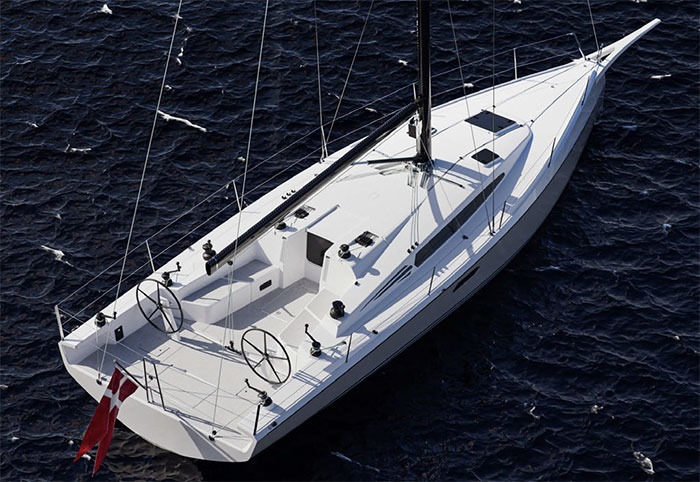
X-Yachts are born to race the Admiral’s Cup 2025
The team at X-Yachts will have been watching Admiral’s Cup 2025 developments with wry smiles. An event at which they were no strangers to the podium back in its heyday. Don’t bet against a repeat performance in 12 months' time...
Over the last few decades, Danish X-Yachts have become increasingly famous for their beautiful, handcrafted performance cruisers. But originally, the brand was built on race wins at the highest level. All through the eighties and the first part of the nineties, a stream of revolutionary new models from X-Yachts won basically every championship there was, primarily under the IOR rule. Only later on did their focus shift to the market for luxury performance cruisers.
Presently, X-Yachts offers three ranges: XP, a performance/ racing oriented range, Pure X, positioned as a clean-cut performance cruising line (in recent years the range with most models on the programme) – and finally XC, which are more dedicated cruising vessels. But the latest model, soon to be revealed, has a radically different profile. Actually, the XR 41 could be the beginning of a new range. And if you hadn’t guessed already, the R stands for racing.

So, the heat is on. In the racing community everyone’s eyes will be glued to this boat – especially next year in August, when the new ORC racer from X-Yachts crosses the start line at the ORC World Championship in Estonia. The ambition is clearly stated: This is a boat built to win the gold medal.
So, is this a story of returning to the roots? CEO Kraen Brinck Nielsen nods. ‘Yes, we are born and bred on the racing scene,’ he says, ‘so it feels really good to have the opportunity again to create a boat that is truly built to win championships. And we take this very seriously. This boat is really hardcore ORC optimised.’
It’s been quite a few years since the last time X-Yachts brought something like this to the table. So, the obvious question is, are they still up to it?
‘Well, we knew we had to approach this task with a certain humility’, says Brinck Nielsen. ‘We have a long tradition of making everything in-house, but this time it was clear that we had to build a team reinforced with external specialists. We wanted to be absolutely sure that we were able to use the best knowledge possible, especially when it comes to optimising for ORC. It’s a very specific know-how that goes into a thing like this.’

‘That’s why we brought in a group of international experts to work closely with our own designers: C Performance with Casper Nielsen, a CFD expert with extensive experience in rating optimisation, and Vmax Yachting with Max Gurgel, a leading rating expert, data cruncher. Surge Projects with Javier Jaudenes was also deeply involved, especially with deck layout and interior. Jaudenes is a naval architect, also with CFD knowledge, but he has a lot of experience with superyachts and styling. In addition, we have had professional racers like Bouwe Bekking and Jesper Radich working with us. For the sail inventory, North Sails was a big asset, with especially Jens Christensen and Heine Sørensen contributing as sail designers. All in all, we have had a team with the best people you can get for this kind of thing’.
Brinck Nielsen sounds really happy just talking about the new race boat: ‘It’s a wildly exciting journey’, he says. ‘We have pushed it really far and will continue to do so. We see this boat as a game changer: To my knowledge, nobody has done this before, developed a production raceboat with such a high tech approach – for example, we have used neural networks and AI for the hull optimising. So, let me tell you what the designers did: They started out with three, you might say, families of hull design. They were all run through a CFD programme, able to do small, incremental changes. The results were first put into the ORC rule, to see in what direction the rating would be affected. Then they checked what the VPP predictions were – VPP is software able to predict actual speed potential, through the whole polar spectrum. If we could see a positive effect on VPP, that was bigger than the cost on the rating – or opposite: If the negative effect on VPP was smaller than the gain on the rating – we knew we were moving in the right direction.’

‘I can give you a few examples: There are certain basic parameters for the hull shape. One of them is overhang fore and aft – how long and how high the overhangs are. Another basic parameter is the position of maximum draft. A third is the fullness of the hull, or the distribution of volume, if you will. Is it centred mainly midships, or more evenly towards the ends of the hull, with fuller fore and aft sections?’
He pulls up a drawing on the computer screen. ‘If you look at the renderings’, he says, ‘the final result is a hull with shallow draft, not much rocker, volume quite evenly distributed longships and with quite a bit of overhang, especially at the bow. The stern is fairly V-shaped, with the centreline barely touching the water surface. The hull is really wide for a 12-metre boat: The maximum beam is 4.18 metres.’
Brinck Nielsen has a history of racing himself, at one time even as part of the Soling crew for the later two-time Olympic winner Jesper Bank. ‘If you want to win a sailboat race under a handicap rule’, he says, ‘a lot of different aspects have to be thought about. The strategy has been to focus specifically on ORC category B, and to position the boat in the fastest end of that fleet. It’s a very important asset to be able to get a free lane right off the start line, and to do that you need to be one of the fastest boats upwind in your category.’
‘Now, categories in ORC are based partly on geometrical data – measurements, if you will – and partly on performance data. And the limits dividing the categories can be changed from year to year. Actually, they recently did just that. This is something we have been very aware of: to make sure the boat didn’t suddenly end up on the wrong side and get relegated to being one of the slowest boats in category A.’
It’s fun to win races, but X-Yachts is also a business. And isn’t it true that raceboats rarely make money? ‘That’s true’, he says, ‘nobody knows that better than us. So, we needed to be fairly confident that there was a viable business case in this project. Consequently we spent a lot of time analysing and discussing how to ensure that. We have been very aware of the potential pitfalls of moving into the racing scene. Early on we made a conscious decision not to make this a one design class. We wanted this to be a boat that could be continuously developed.’
‘Once a year we will be able to look at the latest version of the ORC rule and see what the new updates are. Previously an ambitious owner would hire an expert to optimise the boat, but we will be in a position to do annual upgrades here at the yard, offered to all the owners, based on the data our team of experts have come up with. It’s a completely new way of approaching this. You might want to change the keel bulb, use a bigger jib, whatever makes the boat adapt best to the latest version of the rule. We can do that for you’.
‘As you can hear, we are very focused on the rating aspect in this project, including the tricky question of how to address the fact that there will be annual rule changes in the coming years. Of course we can’t change the hull shape, but we can adapt keel, sail plan, rigging, rudder, displacement and several other things.

‘That is one of the biggest reasons for not setting this up as a one design class. When it comes to the hull itself, the only thing we could do is to give ourselves some slack when it comes to how close we were to the limits. If measurements were right on the edge, we could easily find ourselves on the wrong side a year or two from now. We have really been thinking about the future of the boat. This is not going to be a one hit wonder’.
‘And that includes resale value’, he continues. ‘An important question is, what happens after the active racing campaign? I mean, we build boats that don’t break, they last for decades. And a bit like our IMS series from the nineties, the XR 41 can have an active racing career, maybe five years, and then be used for sporty cruising afterwards. To accommodate this, we have built parts of the interior in modules that can be removed for racing and installed for cruising – for example parts of the galley and the lockers in the aft and front cabins. Deck layout is obviously set up for racing with a full crew, but it’s also designed to work for shorthanded use and even for singlehanded sailing.’
Down below, the XR 41 isn’t a raw racer. ‘That wouldn't make sense,’ explains Brinck Nielsen. ‘We have weight optimised a minimalist, functional and stylish interior for weight and balance, making it let's say “sporty comfortable” to stay below deck. Moreover, we are developing a series of modules that can be installed when additional comfort is needed. In principle the XR 41 can be transformed with few interventions from a winning racing boat into a more comfortable yet still very sporty cruising boat.’
As for the sail wardrobe, the XR 41 will come in two versions: Racing and sporty cruising. The racing version will have a square top mainsail and split backstay while the sporty cruising version will come with a smaller sail area, a pinhead mainsail and a single backstay. The keel can be supplied in a couple of different draughts, but 2.40m is the standard. For spinnakers, the main focus is asymmetric – that’s what the boat is set up for, with a relatively long bow sprit. But there is also an option to set it up for symmetrical spinnakers as well.
A raw racer normally has a short life and loses value after a few years. The XR 41 is designed to win races for many years and also to be used for sporty family sailing for decades. An X-Yacht is built to last decades.
Already by May this year, eight boats had been sold on prospect alone. Brinck Nielsen expects 15-20 sold within the year. ‘The ambition is to build around 80 boats over the next eight years’, he says. ‘Our estimate is that 10-15 of these will be hardcore, pure racers. That leaves the majority of the fleet to owners who will obviously also race, but at the same time use their boat for sporty cruising.’
The new XR 41 raceboat will be officially launched at Düsseldorf Boat Show in January next year.





